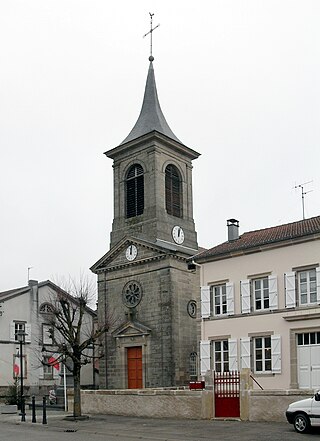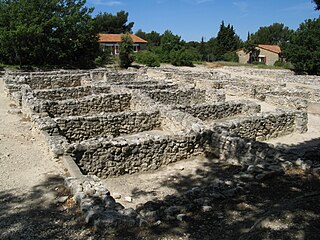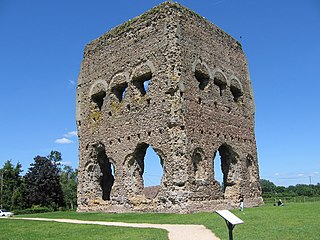Related Research Articles

The Golden Horns of Gallehus were two horns made of sheet gold, discovered in Gallehus, north of Møgeltønder in Southern Jutland, Denmark. The horns dated to the early 5th century, i.e. the beginning of the Germanic Iron Age.

A rune is a letter in a set of related alphabets known as runic alphabets native to the Germanic peoples. Runes were used to write Germanic languages before they adopted the Latin alphabet, and for specialised purposes thereafter. In addition to representing a sound value, runes can be used to represent the concepts after which they are named (ideographs). Scholars refer to instances of the latter as Begriffsrunen. The Scandinavian variants are also known as fuþark, or futhark; this name is derived from the first six letters of the script, ⟨ᚠ⟩, ⟨ᚢ⟩, ⟨ᚦ⟩, ⟨ᚨ⟩/⟨ᚬ⟩, ⟨ᚱ⟩, and ⟨ᚲ⟩/⟨ᚴ⟩, corresponding to the Latin letters ⟨f⟩, ⟨u⟩, ⟨þ⟩/⟨th⟩, ⟨a⟩, ⟨r⟩, and ⟨k⟩. The Anglo-Saxon variant is known as futhorc, or fuþorc, due to changes in Old English of the sounds represented by the fourth letter, ⟨ᚨ⟩/⟨ᚩ⟩.
The Pillar of the Boatmen is a monumental Roman column erected in Lutetia in honour of Jupiter by the guild of boatmen in the 1st century AD. It is the oldest monument in Paris and is one of the earliest pieces of representational Gallo-Roman art to carry a written inscription.
A runic inscription is an inscription made in one of the various runic alphabets. They generally contained practical information or memorials instead of magic or mythic stories. The body of runic inscriptions falls into the three categories of Elder Futhark, Anglo-Frisian Futhorc and Younger Futhark.

Seeland-II-C is a Scandinavian bracteate from Zealand, Denmark, that has been dated to the Migration period. The bracteate bears an Elder Futhark inscription which reads as:

The Thorsberg chape is an archeological find from the Thorsberg moor, Germany, that appears to have been deposited as a votive offering. It bears an Elder Futhark runic inscription, one of the earliest known, dating to roughly 200 CE.

The Ring of Pietroassa or Buzău torc is a gold torc-like necklace found in a ring barrow in Pietroassa, Buzău County, southern Romania, in 1837. It formed part of a large gold hoard dated to between 250 and 400 CE. The ring itself is generally assumed to be of Roman-Mediterranean origin, and features a Gothic language inscription in the Elder Futhark runic alphabet.

The Viromanduī or Veromanduī were a Belgic tribe dwelling in the modern Vermandois region (Picardy) during the Iron Age and Roman periods. During the Gallic Wars, they belonged to the Belgic coalition of 57 BC against Caesar.
The Westeremden yew-stick is a yew-wood stick found in Westeremden in the Groningen province of the Netherlands in 1917. It bears an Old Frisian runic inscription, dated to the second half of the 8th century. With a total of 41 letters, this is the longest of the extant Frisian runic inscriptions.

Pouzilhac is a French commune in the Gard department in southern France, formerly Languedoc-Roussillon.

Mazeley is a commune in the Vosges department in Grand Est in northeastern France.

Entremont is a 3.5-hectare (8.6-acre) archaeological site three kilometres from Aix-en-Provence at the extreme south of the Puyricard plateau. In antiquity, the oppidum at Entremont was the capital of the Celtic-Ligurian confederation of Salyes. It was settled between 180 and 170 B.C., somewhat later than the inhabitation of other oppida, such as Saint-Blaise. The site was abandoned when it was taken by the Romans in 123 B.C. and replaced by Aquae Sextiae, a new Roman city founded at the foot of the plateau. By 90 B.C., the former oppidum was completely uninhabited.
Michel Auguste Martin Agénor Azéma de Montgravier was a French archaeologist and soldier.
The archaeological site of Alba-la-Romaine, corresponding to the Gallo-Roman city of Alba Augusta Helviorum or Alba Helviorum is located near the present town of Alba-la-Romaine. The site is in the French department of Ardèche, Rhône-Alpes. During the Roman Imperial era, Alba was the capital of the Celtic-speaking polity of Helvii, which had territory covering the area of lower Vivarais.
The Avatici were a Gallic tribe dwelling near the Étang de Berre, between the mouth of the Rhône river and Massilia, during the Roman period.

The "Temple of Janus" is a Romano-Celtic religious structure located in Autun, Saône-et-Loire, France, to the North-West of the ancient city of Augustodunum.

The Tour de Grisset is the remains of a small, Gallo-Roman temple or fanum located in Fréteval, Loir-et-Cher, France. It is one of the few Gallo-Roman fana to still be standing, and perhaps the only one with its brick vault still in place. Excavations in the 1960s revealed a bath complex and series of other structures at the site, and it has been proposed that a small, secondary agglomeration of structures may also exist there.

The Jublains archeological site is a cluster of ruins, mostly dating back to Ancient Rome, in the current French commune of Jublains in the département of Mayenne in the Pays de la Loire.

The mausoleum of Lanuéjols is a Gallo-Roman funerary monument located in the commune of Lanuéjols, in the French Department of Lozère.

The pillar of Yzeures-sur-Creuse is an ancient monumental column constructed from Jurassic limestone with shell inclusions. Some remnants were discovered in and near the foundations of the former church of the French commune of Yzeures-sur-Creuse, in Indre-et-Loire in 1895.
References
- ↑ "I have not inspected these items, but find-histories and photographs were self-evident." Looijenga, Tineke (2004). Texts and Contexts of the Oldest Runic Inscriptions. Leiden: Brill. p. 130. ISBN 90-04-12396-2.
- Lydie Joan, Carte archéologique de la Gaule. Le Doubs et le territoire de Belfort, vol. 25/90, Editions MSH (2003), ISBN 978-2-87754-082-7 (with Michel's 1921 drawing Carte archéologique de la Gaule: 25/90. Le Doubs et le territoire de Belfort).
- H. Michel, Rhodania 3e congrès (1921), 481-482.
- R. Milliat, 'L'inscription runique d'Arguel', Archéologia 12 (1966).
- R. Milliat, 'Le caillou d'Arguel', Archéologia 13 (1966).
- G. Bizet, 'Die runische Inschrift von Arguel', in: Jahrbuch des Marburger Universitätsbundes (1964), 41-52.